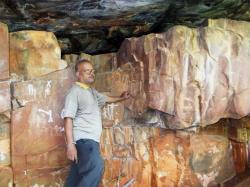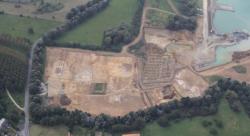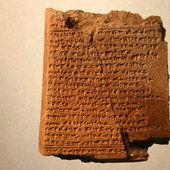INSTITUT SUPERIEUR D'ANTHROPOLOGIE
INSTITUTE OF ANTHROPOLOGY
ONLINE COURSES / COURS A DISTANCE
WINTER TERM : JANUARY 2015
REGISTER NOW
USA –  Timbuctoo - Among the 15,400 artifacts Temple University archaeology students unearthed at Timbuctoo - a buried village of freed and runaway slaves along Rancocas Creek - was a tiny, cast-iron buffalo. There was also a little gun and a wagon wheel, all of which might have been part of a bank set" for a child to collect coins. The final batch of artifacts - including tiny pieces of glass from bottles found up to two feet below the surface - are being washed, analyzed, and catalogued, Because the excavation area is now covered over, the nearly three-acre site near the creek appears as just a grassy field with a hill and small cemetery off Church Road. Tucked into a stand of towering trees next to the field, the cemetery is the only visible sign of the site's storied past. It bears the tombstones of 13 members of the U.S. Colored Troops who fought in the Civil War and lived in Timbuctoo. Historians believe Timbuctoo was an enclave where as many as 125 African American families lived, starting around 1825 and ending in the mid-20th century. A stop on the Underground Railroad for runaway slaves, it was also the setting for Battle of the Pine Swamp in 1860. In that encounter, the villagers used axes, knives, and guns to ward off a slave catcher when he arrived with a dozen helpers to wrest away the freedom of a black man living among them, according to several historic accounts. Chang said Temple's archeological dig had uncovered the cornerstone and outline of an African American church that was once part of Timbuctoo. Physical evidence of several houses was also found, she said, and future digs may reveal a larger area. She said town officials would like to continue to acquire properties around the site and along the creek, where she said runaway slaves would arrive by canoe. Scientific surveys have determined about 70 people were buried in the cemetery despite the scarce markers, she said.
Timbuctoo - Among the 15,400 artifacts Temple University archaeology students unearthed at Timbuctoo - a buried village of freed and runaway slaves along Rancocas Creek - was a tiny, cast-iron buffalo. There was also a little gun and a wagon wheel, all of which might have been part of a bank set" for a child to collect coins. The final batch of artifacts - including tiny pieces of glass from bottles found up to two feet below the surface - are being washed, analyzed, and catalogued, Because the excavation area is now covered over, the nearly three-acre site near the creek appears as just a grassy field with a hill and small cemetery off Church Road. Tucked into a stand of towering trees next to the field, the cemetery is the only visible sign of the site's storied past. It bears the tombstones of 13 members of the U.S. Colored Troops who fought in the Civil War and lived in Timbuctoo. Historians believe Timbuctoo was an enclave where as many as 125 African American families lived, starting around 1825 and ending in the mid-20th century. A stop on the Underground Railroad for runaway slaves, it was also the setting for Battle of the Pine Swamp in 1860. In that encounter, the villagers used axes, knives, and guns to ward off a slave catcher when he arrived with a dozen helpers to wrest away the freedom of a black man living among them, according to several historic accounts. Chang said Temple's archeological dig had uncovered the cornerstone and outline of an African American church that was once part of Timbuctoo. Physical evidence of several houses was also found, she said, and future digs may reveal a larger area. She said town officials would like to continue to acquire properties around the site and along the creek, where she said runaway slaves would arrive by canoe. Scientific surveys have determined about 70 people were buried in the cemetery despite the scarce markers, she said.
http://www.philly.com/philly/news/new_jersey/20141201_Artifacts_at_site_of_former_slaves__village_tell_historic_tale.html
INDE –  Ranibavi- A rock art painting site dating back to neolithic (New Stone Age) and megalithic (Iron Age) and up to the early historic period (from 4,500 BC to 2 AD) was discovered in Lankamala reserve forest at Ranibavi near Mydukur in Kadapa district. More than 100 rock art paintings with mystic figures belonging to human and wild animals in different postures depicted with white pigment were found on quartzite rocks in a rock shelter known as “Diviti Mallanna Banda” or “Mallugani Banda”, about nine kilometres from Ranibavi by V. Ramabrahmam, Assistant Professor of History and Archaeology in Yogi Vemana University, Kadapa, who led an exploration team. “The human figures in the rock art painting site included a man holding a trident, nandipadas, man riding a wolf holding trident with both hands, human figure with a mask, a warrior carrying a weapon riding a horse, another horse-borne warrior confronting an elephant with a weapon, a group of four men with two holding tridents, and men stretching their hands towards a woman,” Dr. Ramabrahmam said. Another interesting rock art painting was that of an antelope and three hyenas ready to attack three wild donkeys. The figure of a tree with a honey comb and a magnified image of the honey comb near the tree indicated that honey was a major food supplement of rock art dwellers. The prehistoric man used saliva, animal fat and crushed bones as binding material that made the pigment last for thousands of years, he said. “The rock art painting site was in the red sanders belt where shoot at sight orders were in force and frequented by wild animals and the exploration team could visit the site with the assistance of forest officials,” Dr. Ramabrahmam said.
Ranibavi- A rock art painting site dating back to neolithic (New Stone Age) and megalithic (Iron Age) and up to the early historic period (from 4,500 BC to 2 AD) was discovered in Lankamala reserve forest at Ranibavi near Mydukur in Kadapa district. More than 100 rock art paintings with mystic figures belonging to human and wild animals in different postures depicted with white pigment were found on quartzite rocks in a rock shelter known as “Diviti Mallanna Banda” or “Mallugani Banda”, about nine kilometres from Ranibavi by V. Ramabrahmam, Assistant Professor of History and Archaeology in Yogi Vemana University, Kadapa, who led an exploration team. “The human figures in the rock art painting site included a man holding a trident, nandipadas, man riding a wolf holding trident with both hands, human figure with a mask, a warrior carrying a weapon riding a horse, another horse-borne warrior confronting an elephant with a weapon, a group of four men with two holding tridents, and men stretching their hands towards a woman,” Dr. Ramabrahmam said. Another interesting rock art painting was that of an antelope and three hyenas ready to attack three wild donkeys. The figure of a tree with a honey comb and a magnified image of the honey comb near the tree indicated that honey was a major food supplement of rock art dwellers. The prehistoric man used saliva, animal fat and crushed bones as binding material that made the pigment last for thousands of years, he said. “The rock art painting site was in the red sanders belt where shoot at sight orders were in force and frequented by wild animals and the exploration team could visit the site with the assistance of forest officials,” Dr. Ramabrahmam said.
http://www.thehindu.com/news/national/andhra-pradesh/early-historic-period-rock-painting-site-found-in-kadapa/article6652127.ece
INDE –  Hyderabad - Remnants of walls, water channel and numerous pottery shreds belonging to the Qutb Shahi period have been discovered during the excavation at the Qutb Shahi tombs during a 10-day archaeology workshop here.
Hyderabad - Remnants of walls, water channel and numerous pottery shreds belonging to the Qutb Shahi period have been discovered during the excavation at the Qutb Shahi tombs during a 10-day archaeology workshop here.
http://twocircles.net/2014dec01/1417446766.html#.VHyXjTGG-pA
FRANCE –  Brissay-Choigny – Le chantier de Brissay-Choigny vient d’être interrompu, pour être repris au printemps prochain, lorsque les conditions hivernales les rendront de nouveau possibles. Dans le vaste champ situé en bordure de la route reliant Brissay-Choigny à Vendeuil, les archéologues ont mis au jour les restes d’habitations du moyen-âge. « Il nous reste à interpréter ces découvertes mais a priori, il s’agit de deux fermes, bâtie en calcaire blanc, probablement au XIVe ou XVe siècle, ainsi que d’autres bâtiments restés au-dessus du colmatage de la rivière », explique Christine Denimal, responsable des fouilles.Son équipe a aussi relevé la présence d’aménagement « en rapport ou antérieurs à ces habitations, un ponton, un maintien de berge et beaucoup d’éléments liés à la pêche, comme un fragment de nasse. » Ces éléments confirme les enseignements de fouilles antérieures. Car le site des carrières de Brissay-Choigny est sous surveillance depuis 2004. Depuis cette date, il a fait l’objet de nombreuses fouilles. En 2012, l’Inrap (institut national de recherches archéologiques préventives), avait découvert la carcasse d’une pirogue de cinq mètres de long, témoin de l’activité de pêche qui animait autrefois la vallée de l’Oise.
Brissay-Choigny – Le chantier de Brissay-Choigny vient d’être interrompu, pour être repris au printemps prochain, lorsque les conditions hivernales les rendront de nouveau possibles. Dans le vaste champ situé en bordure de la route reliant Brissay-Choigny à Vendeuil, les archéologues ont mis au jour les restes d’habitations du moyen-âge. « Il nous reste à interpréter ces découvertes mais a priori, il s’agit de deux fermes, bâtie en calcaire blanc, probablement au XIVe ou XVe siècle, ainsi que d’autres bâtiments restés au-dessus du colmatage de la rivière », explique Christine Denimal, responsable des fouilles.Son équipe a aussi relevé la présence d’aménagement « en rapport ou antérieurs à ces habitations, un ponton, un maintien de berge et beaucoup d’éléments liés à la pêche, comme un fragment de nasse. » Ces éléments confirme les enseignements de fouilles antérieures. Car le site des carrières de Brissay-Choigny est sous surveillance depuis 2004. Depuis cette date, il a fait l’objet de nombreuses fouilles. En 2012, l’Inrap (institut national de recherches archéologiques préventives), avait découvert la carcasse d’une pirogue de cinq mètres de long, témoin de l’activité de pêche qui animait autrefois la vallée de l’Oise.
http://www.aisnenouvelle.fr/region/archeologie-brissay-choigny-revele-son-passe-de-ia16b108n146308
TURQUIE –  Kayalipinar -Kayalıpınar this year, the Culture and Tourism Ministry and the Philipps University of Marburg, Germany on behalf of the Assoc. Dr. VuSLaT Müller-Karpe-led excavations uncovered an ancient Hittite cuneiform tablet in the city's old name as Samuha name has been reached. Culture and Tourism Ministry to the statement made by the ever excavated Hittite settlements Only five of the former name is known Kayalıpın's's former name of Samux determination is regarded as an important breakthrough in this area . BC II. per thousand in Anatolia, the most important one of the cities that envisaged , Samuha name , in Bogazköy in written sources often now known that , in Turkey, the oldest written documentsand which Kültepede Old Assyrian language cuneiform tablets also Samuha from mentioned. Assyrian merchants that trade a small market place ( I Vabart ) , which later evolved Samux BC An important trade center in the 18th century ( Karim ) had become . Kayalıpınar written documents dating from this era were found this year in the excavations written in Old Assyrian , Anatolian tablets have been uncovered by a merchant . However, during the reign of the Hittite Kingdom ( 17 BC-13 . Century ) is a major city in the Samuha Telepinu of the Hittite King ( 1500 BC ) built a warehouse where the image is known from written sources . Great Hittite King of the Kingdom that ruled the country at the center of the Samux at M.Ö.14 . century palace of the great King Tuthaliya with the people of the country where Samuha directed here , even in the dead Samuha is known.
Kayalipinar -Kayalıpınar this year, the Culture and Tourism Ministry and the Philipps University of Marburg, Germany on behalf of the Assoc. Dr. VuSLaT Müller-Karpe-led excavations uncovered an ancient Hittite cuneiform tablet in the city's old name as Samuha name has been reached. Culture and Tourism Ministry to the statement made by the ever excavated Hittite settlements Only five of the former name is known Kayalıpın's's former name of Samux determination is regarded as an important breakthrough in this area . BC II. per thousand in Anatolia, the most important one of the cities that envisaged , Samuha name , in Bogazköy in written sources often now known that , in Turkey, the oldest written documentsand which Kültepede Old Assyrian language cuneiform tablets also Samuha from mentioned. Assyrian merchants that trade a small market place ( I Vabart ) , which later evolved Samux BC An important trade center in the 18th century ( Karim ) had become . Kayalıpınar written documents dating from this era were found this year in the excavations written in Old Assyrian , Anatolian tablets have been uncovered by a merchant . However, during the reign of the Hittite Kingdom ( 17 BC-13 . Century ) is a major city in the Samuha Telepinu of the Hittite King ( 1500 BC ) built a warehouse where the image is known from written sources . Great Hittite King of the Kingdom that ruled the country at the center of the Samux at M.Ö.14 . century palace of the great King Tuthaliya with the people of the country where Samuha directed here , even in the dead Samuha is known.
son of I. Suppiluliuma Samuha out of the many time , very developed at that time the kingdom of the Hittites world of the Pharaohs ruled Egypt, the former is known to be one of the most powerful states .
http://ankara.habermonitor.com/en/haber/detay/kayalipin-important-invention-in-the-2014-exc/474583/
ROYAUME UNI –  Brenkley Lane Surface Mine - Archaeologists working at a regional surface mine have uncovered an Iron Age settlement. Excavations carried out by Headland Archaeology at the Brenkley Lane Surface Mine, which is to the north of Newcastle, have revealed a sprawling Iron Age settlement across a five-hectare area which is centred on four roundhouses within a double rectangular enclosure. The two month-long dig has revealed a complex series of archaeological features spread across the site, with the remains being grouped into three main phases of activity. The majority of the remains uncovered relate to an extensive period of occupation during the Iron Age, and date back well over 2,000 years. They consist of a series of large rectangular ditches enclosing several concentrations of ring gullies, which are the foundation trenches of the settlement's buildings. Pits and other linear features, such as boundary and enclosure ditches, have also been uncovered, with the central enclosed area containing closely aligned ring gullies that suggested buildings had been rebuilt several times. The artefacts, which include iron age quernstones for processing grain, a spindle whorl for weaving, 'briquetage' ceramic vessels that were used in salt transportation and bronze age pottery, suggest that a mixture of domestic and food-processing activities were carried out in the area, with further similar features to the west of the site thought likely to relate to the management of livestock.
Brenkley Lane Surface Mine - Archaeologists working at a regional surface mine have uncovered an Iron Age settlement. Excavations carried out by Headland Archaeology at the Brenkley Lane Surface Mine, which is to the north of Newcastle, have revealed a sprawling Iron Age settlement across a five-hectare area which is centred on four roundhouses within a double rectangular enclosure. The two month-long dig has revealed a complex series of archaeological features spread across the site, with the remains being grouped into three main phases of activity. The majority of the remains uncovered relate to an extensive period of occupation during the Iron Age, and date back well over 2,000 years. They consist of a series of large rectangular ditches enclosing several concentrations of ring gullies, which are the foundation trenches of the settlement's buildings. Pits and other linear features, such as boundary and enclosure ditches, have also been uncovered, with the central enclosed area containing closely aligned ring gullies that suggested buildings had been rebuilt several times. The artefacts, which include iron age quernstones for processing grain, a spindle whorl for weaving, 'briquetage' ceramic vessels that were used in salt transportation and bronze age pottery, suggest that a mixture of domestic and food-processing activities were carried out in the area, with further similar features to the west of the site thought likely to relate to the management of livestock.
http://www.itv.com/news/tyne-tees/2014-12-01/iron-age-settlement-unearthed-at-north-east-mine/?
INDE –  Haradanahalli - As many as 93 ancient gold coins were found while digging the ground to build a toilet in the backyard of a house in Haradanahalli village in the taluk on Monday. One of the coins belongs to Haider Ali’s era, and it is said to have a picture of Shiva and Parvathi sculpted on one side and a picture of Haider Ali sculpted on the other side. The remaining 92 coins are said to have originated in the Thanjavur Maratha’s era.
Haradanahalli - As many as 93 ancient gold coins were found while digging the ground to build a toilet in the backyard of a house in Haradanahalli village in the taluk on Monday. One of the coins belongs to Haider Ali’s era, and it is said to have a picture of Shiva and Parvathi sculpted on one side and a picture of Haider Ali sculpted on the other side. The remaining 92 coins are said to have originated in the Thanjavur Maratha’s era.
http://www.deccanherald.com/content/445028/93-ancient-gold-coins-found.html?